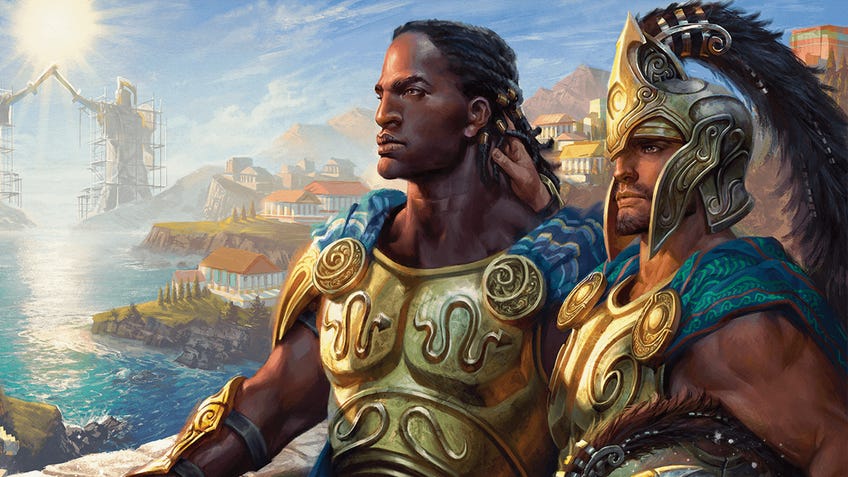“No-one has ever won Dungeons & Dragons”: How Mythic Odysseys of Theros embraces the messier side of D&D 5E
Minotaur illusion.
Mythic Odysseys of Theros isn’t the first time Dungeons & Dragons and Magic: The Gathering have crossed paths, but it might just be one of the weirdest D&D 5E sourcebooks released to date - and I’m counting the official Rick and Morty supplement in that statement.
Having already teamed up to create the Guildmaster’s Guide to Ravnica sourcebook, an adaptation of the popular steampunk Magic: The Gathering plane, Wizards of the Coast’s franchise darlings are back with this newest addition to the Dungeons & Dragons 5E lexicon, this time swapping robotic rebellions for Greek legends.
We wrote this book from the perspective that you don't need to know anything about Magic to use it.
Even though Mythic Odysseys is an adaptation of an existing MTG expansion, co-lead designer for the book, James Wyatt, explains that players can rest assured they won’t need to read up on Magic: The Gathering lore if they want to use the book for their D&D campaign. “The beauty is,'' he says, “we wrote this book from the perspective that you don't need to know anything about Magic to use it.”
Wyatt is in the interesting situation of not only having worked at Wizards of the Coast for around 20 years, but having also been at the creative forefront of both Dungeons & Dragons and Magic: The Gathering during that time. The designer’s wealth of experience working on both the tabletop RPG and trading card game makes him perfectly suited to helming this kind of ambitious crossover; Wyatt calls Orchestrating the creation of Mythic Odysseys “just the latest in my series of efforts to keep a toe in the D&D world”.
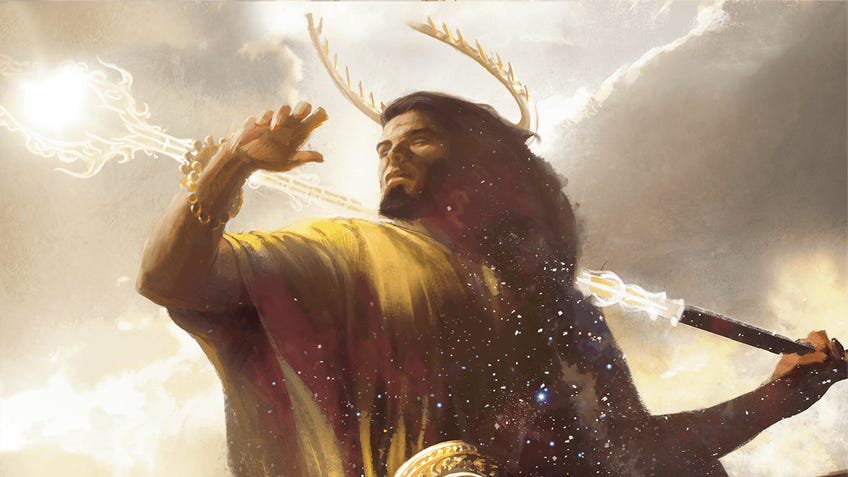
Working alongside Wyatt is F. Wesley Schneider, Mythic Odysseys’ other co-lead designer, who took hold of the writing reins whilst Wyatt conducted the many different voices of internal and external designers working on the book. “James really came at it from an architect's direction,” explains Schneider. “I came at this from much more of a bookmaker’s direction.”
With access to an absolutely enormous pile of art - “The Magic team asked if we would like hundreds of thousands of dollars worth of top-notch fantasy art to include in our book - to which we said: ‘Oh, yes!’” Schneider recalls - Wyatt, Schneider and the rest of the team got to work with bringing the already popular Magic: The Gathering expansion to life.
The plane of Theros was introduced to MTG in late 2013 with a self-titled set that presented a pantheon of gods inspired by Greek mythology, each representing one of the card game’s different mana colours. Wizards of the Coast completed the Theros block in 2014 with two additional sets: Born of the Gods and Journey into Nyx. Earlier this year, Magic: The Gathering returned to the setting after six years with the Theros: Beyond Death expansion, which focused on the concept of the underworld and explored how devotion can be used to gain favour with the gods. After several years of development and the release of Beyond Death, now seemed the ideal time to further explore the plane of Theros.
To the Mythic Odysseys’ team the most instantly intriguing aspect of Theros was its unusual pantheon of gods, which immediately stood out from the deities of D&D past by being undeniably morally ambiguous. Despite the alignment identifiers included with each god in the sourcebook, these deities do not play by the same rules as previous pantheons featured in Dungeons & Dragons sourcebooks. “All of the gods are so petty!” exclaims Schneider. “They want to manipulate the players and further their own goals.”
All of the gods are so petty! They want to manipulate the players and further their own goals.
Whereas Dungeons & Dragons 5E players may be used to the stoic and distant majesty of gods like Bahamut and Bhaal, the pantheon of Mythic Odysseys is more than willing to meddle in mortal affairs to get what they want. While gods have always been a central part of D&D, gods were only officially codified as distinct from other creature cards in MTG when the original Theros block rolled around - making these religious figures have a touch of fallibility about them. The gods might have existed for millenia in the narrative of Theros, but their translation from Magic: The Gathering to D&D is still fresh.
Just because they might be the new kids on the block, that doesn’t mean that these deities haven’t made their mark on the world of Theros. Regardless of their character’s class, players will have to decide which god they choose to align with as part of the piety system introduced in Mythic Odysseys. Unlike previous Dungeons & Dragons sourcebooks, it is not simply clerics and paladins who are blessed with abilities from a deity. In Theros, you’re either worshipping a god or you’re actively standing against them - there is no middle ground.
“If you're worshipping Karametra - one of the gods in Theros - you're getting Karametra-based faith powers depending on how effectively or ineffectively you're serving her,” Schneider explains.
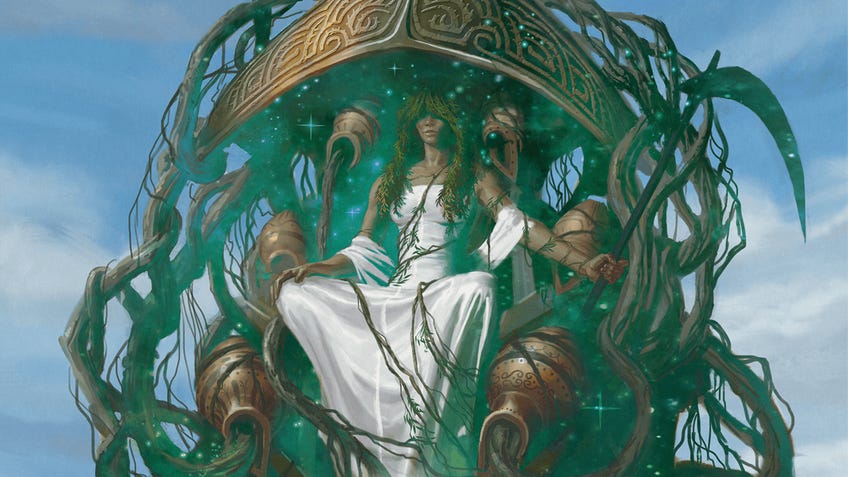
Should a player character decide they don’t want to devote themselves to any particular god they can choose to instead take the iconoclast trait, which essentially gives them abilities designed to fight back against the pantheon. Either way, player characters are going to have to make a choice about where they stand with the gods from the very beginning of their creation, an entirely new concept for many D&D players.
“Religion is absolutely part of the story,” Schneider says.
Despite how inescapable the pantheon may seem in Theros, it is easily one of the most complex and entertaining sets of deities that Dungeons & Dragons has ever seen. This is part due to the influences that Wyatt, Schneider and the rest of the Mythic Odysseys team drew upon. Rather than using the traditional western European-style religions as a basis for inspiration, Mythic Odysseys’ pantheon was concocted using the gods of Greek myth. Schneider describes the deities of Theros as behaving like school bullies, born from the original almighty class of the jealous and vindictive.
“In past D&D sourcebooks maybe you worshipped a god, maybe you’d get a few domains, but your god is rarely right there,” Schneider compares, “and when they are right there, they're probably not behaving like the worst person in your high school.”
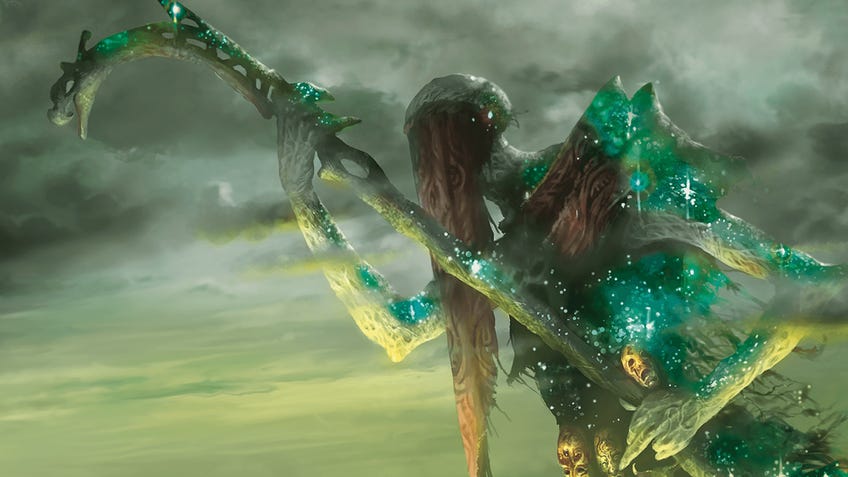
Of course, with such a dysfunctional family of deities occupying the heavens - and in some cases, the underworld - there’s bound to be some tension. Wyatt, Schneider and their co-creators wrote reams and reams of notes about the different relationships between the gods - so much so that accounts eventually started to contradict one another. In many ways, the process mirrored the effect of oral storytelling in both the land of Theros and the real world, as the many differing voices created multiple interpretations of the same stories.
Rather than becoming a problem, the conflicting accounts helped to build upon the Theros pantheon’s existing complexities by illustrating each god’s differing opinions on one another.
I may be a big fan of my neighbour, but my neighbour might hate me. You never really know, and that can be a really interesting source of storytelling.
“In some cases, we're really cool with the misalignment,” says Schneider, “because I may be a big fan of my neighbour, but my neighbour might hate me. You never really know, and that can be a really interesting source of storytelling.”
The unpredictability of the gods, how they react to the world of mortals and to each other, is a fundamental part of what makes Mythic Odysseys feel so epic. Not so much in the sense of size, but more in the possibility of the events and interactions players can experience in Theros. Thanks to the complex morality of the gods and their willingness to get mortals involved, at any moment, things can quickly escalate beyond what players bargained for.

“For example, Heliod - the god of the sun - decides that Erebos and Mogus, two other gods, have been fighting for too long and he's just going to kill them,” Wyatt describes. “That takes your campaign scale from ‘We're down here dealing with mortal stuff’ to ‘We’re going to heaven now!’”
Stories in Theros have a tendency to fly off in wild directions, and often lean into the spectacle of epic fights, enormous monsters and insurmountable odds of legend rather than reality. According to Wyatt and Schneider, history in Theros quickly metamorphosises into myth, taking just 100 years of oral storytelling among the world’s inhabitants to alter the narrative in such a way that it ceases to resemble the original events. This aspect of the setting is intended to invoke the feeling of stepping into a collection of Greek myths - the kind that Schneider used to adore when he was young - and being able to directly contribute to those legends.
“It was almost accidental that we landed on Mythic Odysseys of Theros for the title of this book,” admits Wyatt, “but the mythic aspect of it actually is one of the most exciting things about the book for me.”
The importance of narrative in Theros takes on extra significance when you consider that the act of playing Dungeons & Dragons is a form of oral storytelling in itself. Having players experience oral storytelling both inside and outside of the world of Theros makes it easy to become immersed in a Mythic Odysseys campaign and gives the players’ stories a sense of authenticity - as if they too are adding to the mythos of Theros alongside all the other D&D players exploring this world.
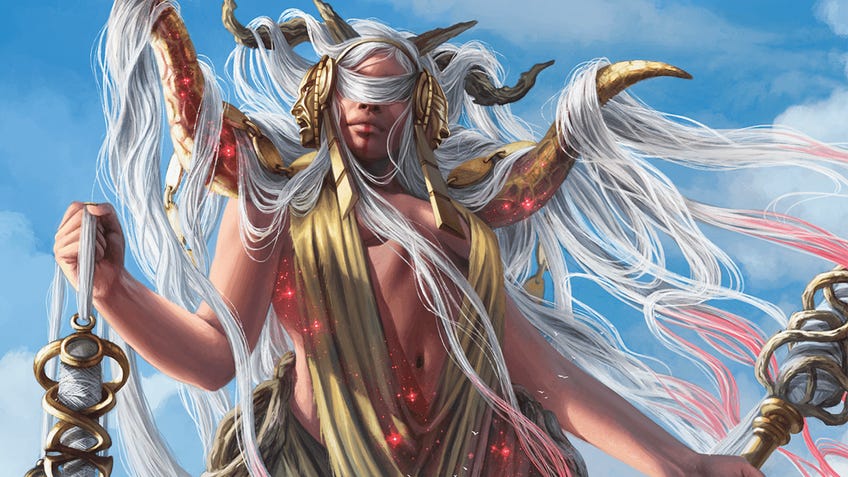
Whilst the characters’ actions and motives in those stories are determined by the players, they will always be struggling against the seemingly unrelenting pull of destiny. Aside from there being an actual god of destiny - the mysterious Klothys - destiny is a force in itself in Theros, one that cannot be ignored. This is most apparent in the sourcebook’s section on heroic drives, which encourages players to consider what they want to achieve during their time in Theros. Holy ideals - a character’s motivation to enact the will of their chosen god - are the biggest source of these heroic drives but, as with the iconoclast trait, player characters can choose to base their heroic drives on something else.
Despite how many conflicting forces are at play in Theros, whether it’s the gods’ will or the concept of fate itself, player characters are still given the space to choose who they really are and who they want to be. “A hero is somebody who makes their own fate,” Wyatt explains.
The minotaurs in Theros are in some cases pretty different from what was presented in Magic or in Dungeons & Dragons in the past.
This discussion is most relevant when talking about character races such as the minotaurs, who are primarily raised in a society that worships a bloody-thirsty god called Mogis and name their young after great minotaurs of the past. Though minotaurs may initially come across as being a culture of morally evil beings, Schneider stresses that players can create characters that do not conform to this expectation: “The minotaurs in Theros are in some cases pretty different from what was presented in Magic or in Dungeons & Dragons in the past. Here, they could be wizards and they can be bakers and some of them like needlepoint.”
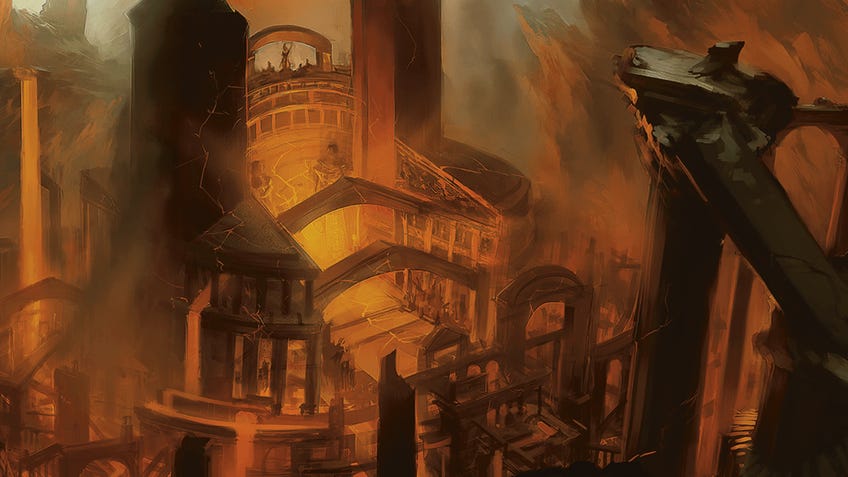
The multifaceted portrayal of minotaurs in Mythic Odysseys of Theros echoes the wider initiative being taken by Dungeons & Dragons publisher Wizards of the Coast to remove some of the more regressive aspects of the fantasy RPG, such as the negative depictions of drow and racial modifiers, in an effort to make all races feel more morally and culturally complex than past examples.
In light of Theros’ squabbling gods, misleading stories and tragic heroes, it makes perfect sense for players to create characters who embrace the messy nature of the setting. From including gameplay elements inspired by classical tales such as the tragic flaw - an aspect that player characters must battle with throughout their journey - to having characters devote themselves to gods who appear far from divine, Mythic Odysseys is a push towards having players create imperfect characters rather than the atypical stat-optimised characters of D&D past.
Fundamentally flawed characters are what makes this game.
Wyatt describes a story in which one of his D&D characters chose to roll - and fail - against an ally’s ability, causing the character to experience a setback. After tweeting the story, he received several confused replies from other Dungeons & Dragons players asking why he had done so - to which he replied: “Fundamentally flawed characters are what makes this game.”
“This is the push against the tide that's just like, ‘Oh, I want to win Dungeons & Dragons,” adds Schneider. “No-one has ever won Dungeons & Dragons.”
The beautiful mess of Theros - its selfish gods, inaccurate history and flawed characters - appear to make it a different kind of D&D sourcebook, one that continues to pathe the way towards a more interesting Dungeons & Dragons.
